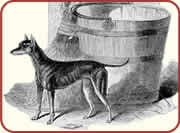
| History of British Dog | Classification | Linnaeus | Buffon | Stonehenge |
| Classification of Dogs | |
Ay, in the catalogue ye go for men ; As hounds, and greyhounds, mongrels, spaniels, curs, Shoughs, water-rugs and demi-wolves, are clept All by the name of dogs : the valued file Distinguishes the swift, the slow, the' subtle, The housekeeper, the hunter, every one According to the gift which bounteous nature Hath in him closed. ,, , , . Macbeth Act 3, Sc. i : SHAKESPEARE |
|
| The history of the domestic dog has been chronicled
in English since the first serious attempt to produce a logical classification
of the breeds. Dame Juliana Berners (Barnes or Bernes) ,in her treatise on hunting in the Boke of St. Albans, which was first published in 1486 by a schoolmaster at St. Albans, gave what was the first list of recognised breeds to be printed in English. " Thyse ben thenames of houndes," she wrote, " fyrste there is a Grehoun, a Bastard, aMengrell, a Mastiff, a Lemor, a Spanyel, Raches, Kenettys, Teroures,Butchers' Houndes, Myddyng dogges, Tryndel-taylles, and Prikherid currys, and smalle ladyes' poppees that bere awaye the flees." Theclassification was very limited, but it served to illustrate the importance attached even at that time to certain breeds of dogs and their purpose which have to this day retained their original nomenclature. Dame Juliana's book was apparently well received and became popular in the sixteenth century (when it ran to several impressions) at the same time as the learned contribution of Dr. Caius was published. This earliest attempt at a complete classification of dogs was published in 1570 and called De Canibus Britannicus. This treatise was written in Latin by Dr Johannes caius who was the physician to Queen Elizabeth the first and the founder of Caius College Cambridge. It was first translated into English in 1576. Caius divided his first group into 'Venatici' and ' Aucupatorii'. The Venatici were used for the purpose of hunting beasts ; the Aucupatorii were employed in the hunting of fowl. As Dr. Caius wrote," The first findeth game on the land. The other findeth game on the water." His Venatici or Dogges serving y pastime of hunting beasts were divided as follows: Leverarws, or Harriers; Terrarius, or Terrars; Sanguinarius, or Bloodhounds; Agaseus, or Gazehounds; Leporanus, or Grehounds; Loranus, or Lyemmer; Vertigus, or Tumbler; and Cams furax, or Stealer. His Aucupatorii were not so inclusive, and comprised merely : Dogs used for fowling: Index, or Setter; Aquaticus, or Spaniell. The third group of Caius' table of species was devoted entirely to the 'Spaniell Gentle', or 'Comforter'; but the fourth section, that for farm dogs, consists of the following two types : Canis pastoralis, or the Shepherd's Dogge; The Mastive, or Bandogge, called Canis Villaticus Or Carbenarius, which hath sundry names derived from sundry circumstances, The final section, which appears to deal with mongrels, contains the: Admonitor, or Wapp; Vernepator, or Turnespet; Saltator, or Dauncer. |
|
